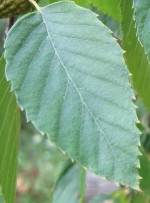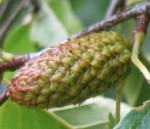 Sweet birch is a deciduous tree also known as black birch, cherry birch, mahogany birch or spice birch, and is native to eastern North America from southern Maine and Ontario, south to northern Georgia and Mississippi, where it grows in dry woods, rocky slopes, and streambanks. It is a member of the birch family, Betulaceae, that also includes hornbeams, alders, and hazels. Trees are usually single stemmed with smooth charcoal-gray bark marked by horizontal lenticels. The twigs emit the scent of peppermint when scraped. The ovate leaves are 2.5 to 6 inches long by 1 ½ -3.5 inches wide, are pleated, and have finely toothed margins. They are shiny green above, paler below, and turn golden yellow in fall. Catkins of male and female flowers appear in the spring on the same tree. The male catkins are pendulous and two to three inches long while the female catkins are, erect, one inch long, and give way to tiny winged nutlets. Sweet birch is a good choice for a specimen tree, shade tree, and tall screen.
Sweet birch is a deciduous tree also known as black birch, cherry birch, mahogany birch or spice birch, and is native to eastern North America from southern Maine and Ontario, south to northern Georgia and Mississippi, where it grows in dry woods, rocky slopes, and streambanks. It is a member of the birch family, Betulaceae, that also includes hornbeams, alders, and hazels. Trees are usually single stemmed with smooth charcoal-gray bark marked by horizontal lenticels. The twigs emit the scent of peppermint when scraped. The ovate leaves are 2.5 to 6 inches long by 1 ½ -3.5 inches wide, are pleated, and have finely toothed margins. They are shiny green above, paler below, and turn golden yellow in fall. Catkins of male and female flowers appear in the spring on the same tree. The male catkins are pendulous and two to three inches long while the female catkins are, erect, one inch long, and give way to tiny winged nutlets. Sweet birch is a good choice for a specimen tree, shade tree, and tall screen.

Type: Deciduous tree
Outstanding Feature: Rapid growth, shade
Form: Upright, oval
Growth Rate: Rapid
Bloom: Male and female catkins on the same tree in spring; male catkins pendulous and two to three inches long; female catkins erect, one inch long
Size: 40-82’ H x 10-25” W
Light: Full sun to part shade
Soil: Humus ich, moderately moist, well-drained, neutral to acid; intolerant of alkaline soil
Hardiness: Zones 4-7
Care: Low maintenance
Pests and Diseases: More resistant to many pests and diseases that plague other birches but susceptible to cankers, leaf miners, aphids and other typical birch problems.
Propagation: Seed